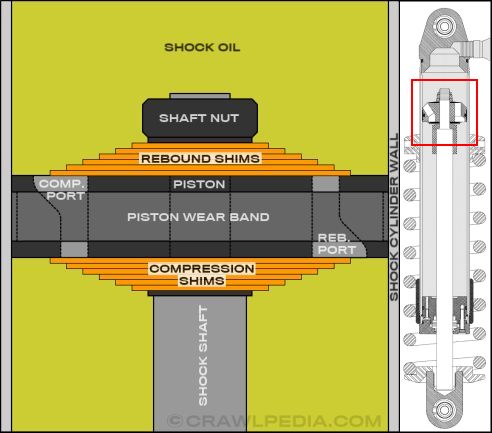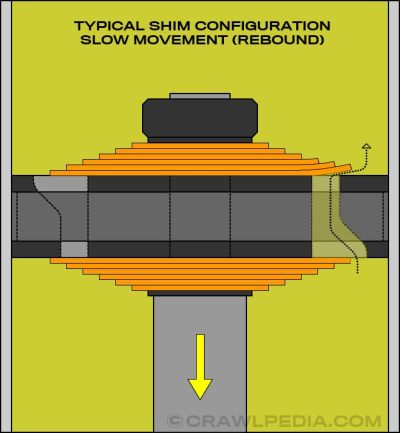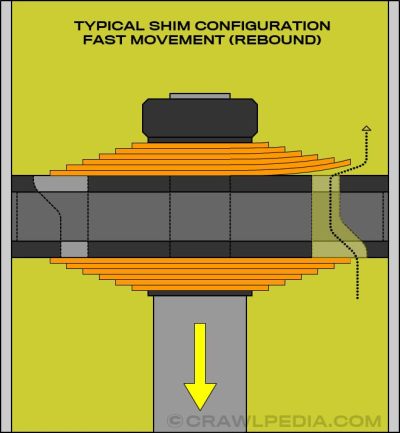How Performance Shock Valving Works
Note: If you wish to skip the basics of how shock valving works and go straight to shock tuning, please see our Shock Tuning Guide.
Shock absorbers dampen the suspension movement of a vehicle to improve handling and performance by forcing specially formulated shock oil through tightly controlled holes (ports) in the shock piston to convert kinetic energy (movement) into thermal energy (heat).
Most high performance shocks are similar in design and feature a piston attached to a shock shaft that moves up and down inside the shock cylinder which is filled with shock oil. Shims placed on either side of the piston, then control the movement of oil through the ports depending on their arrangement.

As the shock shaft moves within the shock body, oil is forced through openings in the piston to push against the shim stack on the opposite side. The faster and harder the shock moves, the higher the force of the oil pressing against the shims becomes. Controlling how much force is needed to allow the oil to move past the shims at any given speed is how shock valving is determined.

Standard Shim Stacks
Shock valving shims are precision machined in various thicknesses and are heat treated to hold up to temperatures exceeding 500 degrees without losing strength. The most common configuration is a pyramid style stack made up of progressively smaller diameter shims which offers excellent damping at all speeds.
The harder and/or faster the shock moves, the higher the force of oil being pressed through the shock piston ports gets and the more shims in the shim stack come into play. As more and more force is applied to the shock, the harder the shims press against the oil to dampen the movement.
An important thing to keep in mind is that all forces absorbed by the shock absorber are converted to heat which is dissipated through the shock oil and out through the shock body. Every shock absorber has a limit to the amount of force it can absorb over a given period of time before the heat generated causes the shock oil to break down or expand to the point of cavitation where the piston hydro-locks. This is why it is not only critical to get the shock valving correct, but to also make sure that your shock is the appropriate size and properly equipped to match the performance of the vehicle.
For more information on shim stack configurations and selecting shim sizes, please see our shock tuning guide and sample shim stack chart.
For one-on-one help selecting the right shocks and valving for your vehicle, contact the team over at Filthy Motorsports.
This shock valving guide is ©Copyright Crawlpedia.com - Please provide a link back to this page when copying.
Data is accurate to the best of our knowledge and is offered as-is with no guarantee.

More Shock Guides:
Shock Rebuild Instructions - Detailed step-by-step instructions for rebuilding high-performance shocks.
Shock Rebuilding Tools - A list of tools needed to service high-performance shocks and coilovers.
Shock Tuning Guide - A guide to how high-performance shocks are tuned and valved to work well.
Shock Valving Shim Stack Examples - A list of common, basic valving shim stack configurations for high-performance shocks.
Coilover Spring Rate Calculator - A calculator to help you determine a good starting point for coilover spring rates.
4-Link Suspension Guide - A quick overview of the most important elements of 4-link geometry.
Shock Rebuild Parts - A link to Filthy Motorsports' shock parts page.
How To Measure For Coilovers - Order the right size shocks and coilovers by following these detailed instructions.
Coilover Install and Setup Guide - Proper coilover installation, setup, and fine tuning instructions.
Coilover Spring Re-Calculation Guide - How to easily correct coilover spring rates to achieve your desired ride height.
ORI STX Struts Guide - An introduction to ORI STX Struts, how they work and how to tune them.
Hydraulic Bump Stop Guide - A detailed overview of hydraulic bump stops and jounce shocks for off-road use.
Filthy Motorsports
High performance off-road racing parts and professional shock tuning. Learn more at
FilthyMotorsports.com
Shock Service, LLC
Professional shock tuning and rebuilding services for King and ADS shocks. Learn more at
ShockService.com
Polar Cryogenics
Cryogenic treatment improves strength and longevity of gears, axle, and brakes. Learn more at
PolarCryogenics.com
Crown Race Gears
Race-spec ring and pinion gears for desert racing, rock bouncing, and rock crawling. Learn more at
RaceGears.com





